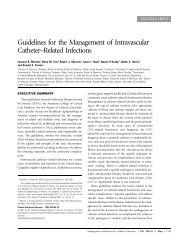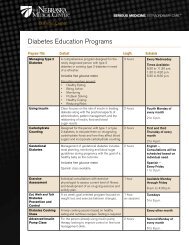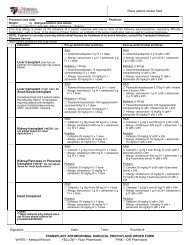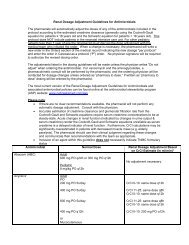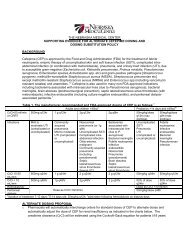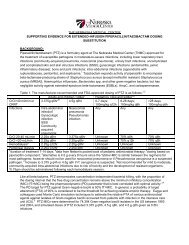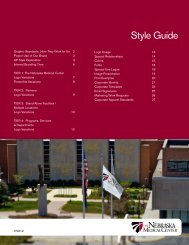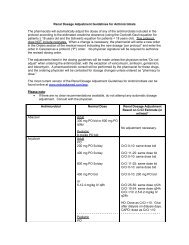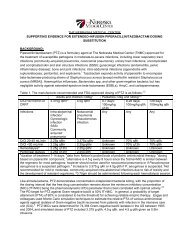Procalcitonin (PCT) Guidance - The Nebraska Medical Center
Procalcitonin (PCT) Guidance - The Nebraska Medical Center
Procalcitonin (PCT) Guidance - The Nebraska Medical Center
Create successful ePaper yourself
Turn your PDF publications into a flip-book with our unique Google optimized e-Paper software.
• Diagnosis of systemic secondary infection post-surgery, post-organtransplant, and in severe burns, multiorgan failure, and severe trauma• Diagnosis of bacteremia and sepsis in adults and children (includingneonates)• Differentiating bacterial verses viral meningitis• Diagnosis of renal involvement in pediatric urinary tract infections• Diagnosis of bacterial infection in neutropenic patients• Diagnosis of septic arthritisWhat is the proposed role for procalcitonin at <strong>The</strong> <strong>Nebraska</strong> <strong>Medical</strong> <strong>Center</strong>?<strong>Procalcitonin</strong> can be used at <strong>The</strong> <strong>Nebraska</strong> <strong>Medical</strong> <strong>Center</strong> to assist clinicians in thediagnosis of infection and to support antimicrobial therapy decisions. Decisionsregarding antimicrobial therapy should NOT be based solely on procalcitoninserum concentrations; procalcitonin should be placed into the clinical context ofeach patient scenario considering the site of possible infection, the likelihood ofbacterial infection, the severity of illness, and any other pertinent clinical data. Itshould be noted that <strong>PCT</strong> levels may not rise with localized infections (osteomyelitis,localized abscess, etc) and a negative <strong>PCT</strong> should not be considered to rule out alocalized infection.Lower respiratory tract infection (pneumonia, COPD exacerbation, bronchitis)Excellent evidence supports the use of <strong>PCT</strong> for assisting clinicians in antibioticmanagement in LRTI including pneumonia, exacerbations of chronic bronchitis, andother assorted lower respiratory tract infections (bronchitis, asthma exacerbation,etc.). A meta-analysis of 8 studies with 3431 patients found the use of <strong>PCT</strong> in LRTIresulted in a 31% decrease in antibiotic prescriptions and a decrease in antibioticduration of 1.3 days. 17Recommended Use: Based upon this evidence it is suggested that patientsconsidered at risk for bacterial LRTI or being started on antibiotics have a <strong>PCT</strong> valuemeasure on admission and every 2-3 days subsequently. Interpretation of values islisted below in Algorithms 1 and 2.



